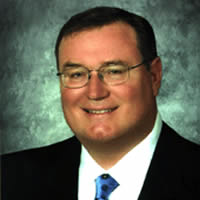Dr. Glen D. Johnson
Chancellor, Oklahoma Higher Education Chancellor
 Dr. Glen D. Johnson is the chief executive officer for the Oklahoma State System of Higher Education. Johnson leads a state system comprised of 25 state colleges and universities, 10 constituent agencies, two higher education centers and independent colleges and universities coordinated with the state system. He reports to a constitutional board whose nine members are appointed by the governor and confirmed by the Senate.
Dr. Glen D. Johnson is the chief executive officer for the Oklahoma State System of Higher Education. Johnson leads a state system comprised of 25 state colleges and universities, 10 constituent agencies, two higher education centers and independent colleges and universities coordinated with the state system. He reports to a constitutional board whose nine members are appointed by the governor and confirmed by the Senate.
Johnson provides leadership on matters relating to standards for Oklahoma higher education, courses and programs of study, budget allocations for institutions, fees and tuition, and strategic planning. He is responsible for an annual higher education budget in excess of $1.9 billion as well as the state endowment fund, with a market value over $400 million. He is responsible for OneNet, the state’s telecommunications network for government and education, as well as the Oklahoma College Assistance Program, which has guaranteed more than one million student loans exceeding $2.5 billion in insured debt.
Johnson directs 20 statewide scholarship programs as well as other programs, including the State Regents’ Summer Academies in Math and Science program and the statewide GEAR UP efforts.
Background
Johnson became eighth chancellor of the Oklahoma State System in January 2007 after a national search. Before assuming the role of chancellor, Johnson served as the 16th president of Southeastern Oklahoma State University in Durant for 10 years.
During his tenure as president at Southeastern Oklahoma State University, Johnson implemented an $85 million capital campaign to build a new student union, residence hall, arena and convention center, biology building, SBDC center and campus security, and a new large classroom building.
Johnson served as director of public policy and adjunct professor of law at the University of Oklahoma College of Law. Prior to his work at OU, Johnson served in the Oklahoma House of Representatives from 1982 to 1996 and was speaker of the House from 1990 to 1996. At the time of his election as speaker, he was the youngest-sitting speaker in the United States.
Johnson has been recognized both statewide and nationally as a strong, untiring advocate for funding for education, both secondary and higher education, in Oklahoma. His powerful political career was a model of success in leadership, as evidenced by the variety of his many major accomplishments not only for his own District 24 (Hughes, Okfuskee and Okmulgee counties), but also in major initiatives, funding and improvements for the entire state of Oklahoma as speaker of the House and chair of important legislative committees. He was also the principal author of the landmark Quality Jobs Bill.
During his term in the House, Johnson was instrumental in the passage of HB 1017, Oklahoma’s landmark education reform legislation, and served as chair of the Appropriations and Budget Committee and the Appropriations Subcommittee on Education. He authored Senate Bill 180 in 1988 that created the Endowed Chairs Program and spearheaded the opportunity to use $14 million from the proceeds of the higher education bond issue for OneNet. In 1992 he was principal author of HB 2428, the $350 million higher education bond issue.
Academic Credentials and Honors
Johnson is an honors graduate of the University of Oklahoma, with an undergraduate degree in political science and a juris doctorate degree from the OU College of Law. He was a member of Phi Beta Kappa and currently serves on the Alpha Tau Omega Fraternity National Foundation board of directors.
Johnson holds memberships in numerous professional, state and national organizations and has been the recipient of many awards and honors during his career. In 2012 he was elected to the Southern Regional Education Board (SREB) and currently serves as vice chairman. In 2013 he was appointed to serve on the American Association of State Colleges and Universities (AASCU) board of directors.
He was also a founding member of the Oklahoma Foundation for Excellence in 1986. He is a member of the Oklahoma Heritage Association’s executive board of directors and was inducted into the Oklahoma Hall of Fame in November 2006. He is a member of the Oklahoma City National Memorial and Museum board of trustees and a member of the Epworth Villa board of directors and the Oklahoma State Fair board of directors. He received an honorary doctorate of humane letters from Oklahoma City University in 2009 and has been named as a Life Fellow of The Fellows of the American Bar Foundation.
Personal
Johnson is the son of former U.S. Congressman Glen D. Johnson Sr. and Imogene Johnson and was born in Oklahoma City. He attended grade school in Washington, D.C. and graduated from Muskogee High School in 1972. Johnson and his wife, Melinda, a teacher at Edmond Memorial High School, live in Oklahoma City.

 Dr. Tim Coburn
Dr. Tim Coburn Matt Stansberry
Matt Stansberry Krish Dhanam
Krish Dhanam